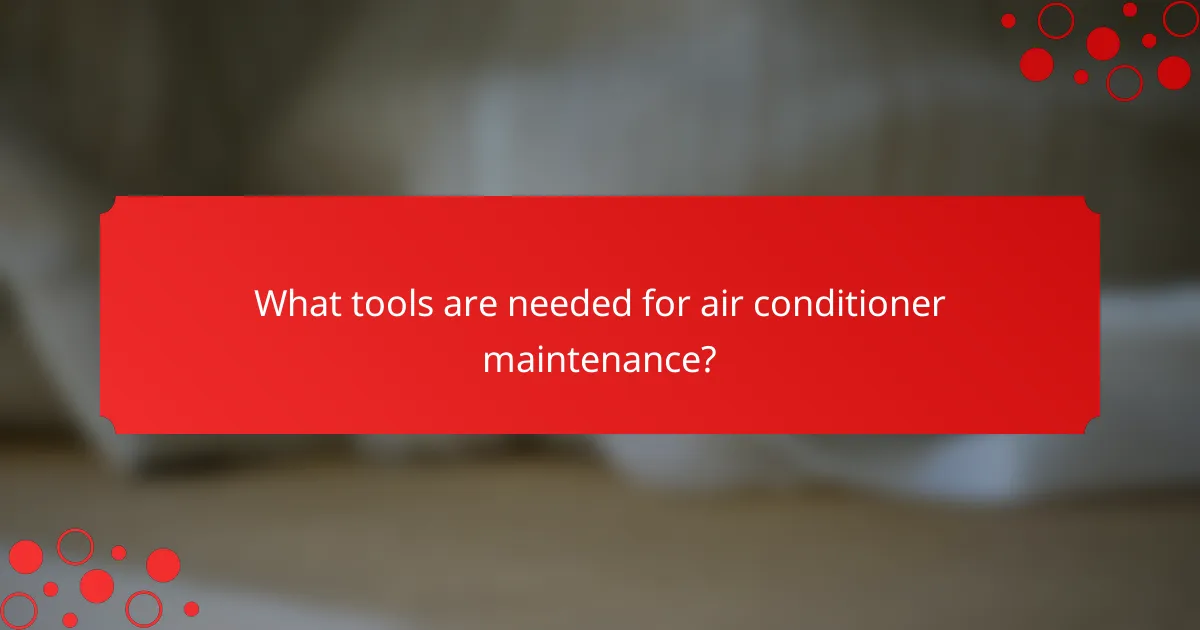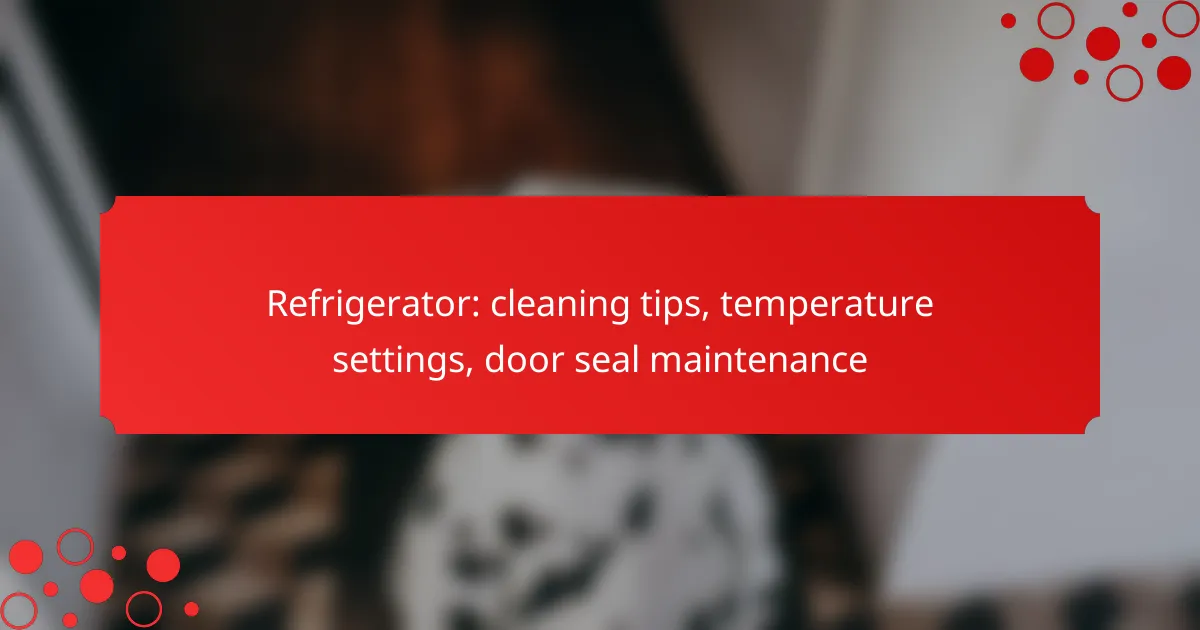Maintaining your air conditioner is crucial for optimal performance and air quality. Regularly replacing filters and scheduling servicing not only enhances efficiency but also extends the lifespan of your unit. Additionally, setting your thermostat between 72°F and 78°F strikes a balance between comfort and energy savings, ensuring effective cooling without unnecessary energy use.

How to replace air conditioner filters?
Replacing air conditioner filters is essential for maintaining optimal performance and air quality. Regular filter changes help ensure efficient airflow and reduce energy consumption.
Step-by-step filter replacement
To replace your air conditioner filter, first, turn off the unit to ensure safety. Locate the filter compartment, which is typically found near the air intake. Remove the old filter by sliding it out gently.
Next, insert the new filter, ensuring it fits snugly in place. Pay attention to the airflow direction indicated on the filter. Finally, close the compartment and turn the air conditioner back on.
Recommended filter types
There are several types of filters available for air conditioners, including fiberglass, pleated, and HEPA filters. Fiberglass filters are inexpensive but less effective at trapping small particles.
Pleated filters offer better filtration and are available in various MERV ratings, which indicate their efficiency. HEPA filters provide the highest level of air purification, making them ideal for allergy sufferers.
Frequency of filter changes
It is generally recommended to change air conditioner filters every one to three months, depending on usage and the type of filter. If you have pets or live in a dusty area, consider changing the filter more frequently.
Regularly checking the filter every month can help you determine if it needs replacement sooner. A clogged filter can lead to reduced efficiency and increased energy costs.

What are the benefits of regular air conditioner servicing?
Regular air conditioner servicing provides numerous benefits, including enhanced performance, increased longevity, and reduced repair costs. By maintaining your system, you ensure it operates efficiently and reliably throughout its lifespan.
Improved efficiency
Regular servicing of your air conditioner ensures that it runs at optimal efficiency. This includes cleaning or replacing filters, checking refrigerant levels, and inspecting components. An efficiently running unit can use significantly less energy, leading to lower utility bills.
For example, a well-maintained air conditioner can operate up to 20% more efficiently than one that is neglected. This efficiency not only saves money but also reduces wear and tear on the system.
Extended lifespan
Routine maintenance can significantly extend the lifespan of your air conditioning system. Regular checks help identify potential issues before they become serious problems, allowing for timely repairs. Most air conditioners can last 15 to 20 years with proper care.
By investing in regular servicing, you can avoid premature replacements, which can be costly. A simple annual check-up can make a substantial difference in how long your unit lasts.
Cost savings on repairs
Regular servicing can lead to substantial cost savings on repairs. By addressing minor issues during routine maintenance, you can prevent them from escalating into major failures that require expensive repairs. This proactive approach can save you hundreds of dollars over time.
Additionally, some service providers offer maintenance plans that include discounts on repairs and priority service. This can further reduce costs and ensure your air conditioner remains in top condition throughout the cooling season.

How to set thermostat for optimal cooling?
To achieve optimal cooling, set your thermostat between 72°F and 78°F (22°C to 26°C). This range balances comfort and energy efficiency, allowing your air conditioner to operate effectively without excessive energy consumption.
Recommended temperature settings
The ideal temperature setting for cooling varies by personal preference and local climate. Generally, a setting of 75°F (24°C) is comfortable for most people during the summer months. If you find it too cool, consider adjusting by one degree at a time to find your sweet spot.
During peak heat hours, you may want to increase the thermostat setting by a few degrees to save energy. For example, setting it to 78°F (26°C) when you’re home and raising it to around 85°F (29°C) when you’re away can lead to significant savings.
Energy-saving modes
Many modern thermostats come with energy-saving modes that automatically adjust the temperature based on your schedule. Utilizing these modes can help reduce energy consumption while maintaining comfort. For instance, a programmable thermostat can lower the temperature before you arrive home and raise it when you leave.
Consider using the “eco” or “energy saver” settings if available. These modes typically optimize cooling cycles to minimize energy use, especially during high-demand periods.
Smart thermostat options
Smart thermostats offer advanced features such as remote control, learning capabilities, and integration with home automation systems. Brands like Nest and Ecobee allow you to adjust settings from your smartphone, making it easy to optimize cooling even when you’re not home.
When choosing a smart thermostat, look for models that provide energy usage reports and suggest optimal settings based on your habits. This can help you make informed decisions about your cooling needs and further enhance energy efficiency.

What tools are needed for air conditioner maintenance?
To maintain an air conditioner effectively, you’ll need a variety of tools that facilitate tasks such as filter replacement, regular servicing, and thermostat adjustments. Having the right tools on hand can streamline the maintenance process and ensure your unit operates efficiently.
Essential maintenance tools
Basic tools for air conditioner maintenance include a screwdriver set, adjustable wrenches, and pliers. These tools are essential for accessing the unit’s components and performing tasks like tightening connections or replacing parts. A multimeter is also useful for checking electrical components and ensuring proper functionality.
Consider investing in a vacuum cleaner with a brush attachment to remove dust and debris from the unit’s exterior and interior. This helps maintain airflow and efficiency. A digital thermometer can assist in checking temperature differentials, which is crucial for diagnosing performance issues.
Cleaning supplies
Cleaning supplies are vital for maintaining air conditioner performance. You’ll need a mild detergent or specialized coil cleaner to clean the evaporator and condenser coils. A soft brush or cloth can help remove dirt without damaging the coils.
Additionally, having disposable filters on hand for quick replacements is essential. Regularly changing filters can improve air quality and efficiency. A spray bottle filled with water and vinegar can also be effective for cleaning surfaces and removing mold or mildew.
Safety equipment
Safety equipment is crucial when performing air conditioner maintenance. Always wear safety goggles to protect your eyes from debris and cleaning chemicals. Gloves are also recommended to prevent skin irritation from cleaning agents or sharp components.
If you’re working on the electrical aspects of the unit, consider using insulated tools to reduce the risk of electric shock. A first aid kit should be readily available in case of minor injuries while performing maintenance tasks.

What are the signs of air conditioner issues?
Signs of air conditioner issues include unusual noises, inconsistent cooling, and increased energy bills. Recognizing these symptoms early can help prevent costly repairs and ensure your system operates efficiently.
Unusual noises
If your air conditioner starts making strange sounds, it may indicate a problem. Common noises include rattling, buzzing, or grinding, which can suggest loose parts, electrical issues, or worn-out components.
Pay attention to the type of noise and when it occurs. For instance, a high-pitched squeal might signal a failing motor, while a clanking sound could mean a loose fan blade. Addressing these issues promptly can prevent further damage.
Inconsistent cooling
Inconsistent cooling is a clear sign that your air conditioner is not functioning properly. If some rooms feel warm while others are cold, it may indicate a problem with the ductwork or the unit itself.
Check your air filters first, as dirty filters can restrict airflow. If the filters are clean, consider having a professional inspect the system for refrigerant leaks or compressor issues that could be affecting performance.
Increased energy bills
A sudden spike in your energy bills can suggest that your air conditioner is working harder than it should. This inefficiency may stem from issues like dirty coils, low refrigerant levels, or mechanical problems.
To combat rising costs, regularly maintain your unit by cleaning or replacing filters and scheduling professional servicing. Keeping your system in good shape can help maintain energy efficiency and lower your monthly expenses.

How to choose an air conditioner service provider?
Selecting a reliable air conditioner service provider is crucial for maintaining your system’s efficiency and longevity. Look for companies with a solid reputation, proper certifications, and transparent pricing to ensure quality service.
Key selection criteria
When choosing an air conditioner service provider, consider their experience and qualifications. Look for technicians who are certified by recognized organizations, as this indicates they have undergone proper training and adhere to industry standards.
Additionally, check for customer reviews and ratings. A provider with consistently positive feedback is likely to deliver satisfactory service. It’s also beneficial to inquire about their warranty policies and whether they offer maintenance plans.
Questions to ask technicians
Before hiring a service provider, ask specific questions to gauge their expertise. Inquire about their experience with your particular air conditioning model and any relevant certifications they hold.
Also, ask about their service process, including how they handle emergencies and what their response times are. Understanding their pricing structure and any additional fees for parts or labor can help you avoid unexpected costs.

What are the latest trends in air conditioning technology?
The latest trends in air conditioning technology focus on energy efficiency, smart home integration, and environmentally friendly refrigerants. Innovations such as variable refrigerant flow systems and advanced filtration technologies are becoming increasingly popular, enhancing comfort while reducing energy consumption.
Filter replacement
Regular filter replacement is crucial for maintaining optimal air conditioning performance. Most manufacturers recommend changing filters every one to three months, depending on usage and filter type. Dirty filters can restrict airflow, leading to higher energy costs and reduced cooling efficiency.
To ensure effective filtration, consider using high-efficiency particulate air (HEPA) filters, which can capture smaller particles and allergens. Always check the manufacturer’s guidelines for specific recommendations on filter types and replacement intervals.
Regular servicing
Regular servicing of air conditioning units is essential for longevity and efficiency. A professional service typically includes cleaning coils, checking refrigerant levels, and inspecting electrical components. Scheduling maintenance at least once a year can help prevent costly repairs and ensure the system runs smoothly.
Homeowners can perform basic maintenance tasks, such as cleaning the outdoor unit and ensuring proper airflow around it. Keeping the area free of debris and vegetation can significantly improve the system’s performance.
Thermostat settings
Optimal thermostat settings can enhance comfort and reduce energy costs. A common recommendation is to set the thermostat to around 24-26°C (75-78°F) during the summer months. This range balances comfort with energy efficiency, as each degree lower can increase energy consumption by several percent.
Consider using programmable or smart thermostats that adjust temperatures based on your schedule. These devices can help save energy by automatically raising or lowering the temperature when you’re not home, making it easier to maintain efficiency without sacrificing comfort.



